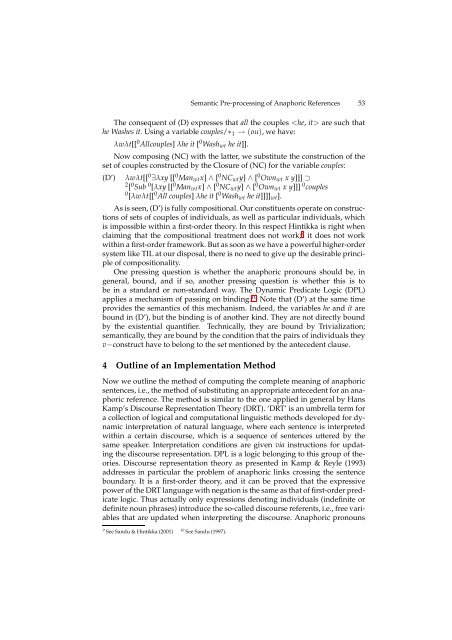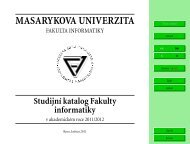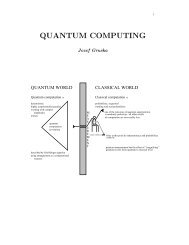Semantic Pre-processing of Anaphoric References
Semantic Pre-processing of Anaphoric References
Semantic Pre-processing of Anaphoric References
You also want an ePaper? Increase the reach of your titles
YUMPU automatically turns print PDFs into web optimized ePapers that Google loves.
<strong>Semantic</strong> <strong>Pre</strong>-<strong>processing</strong> <strong>of</strong> <strong>Anaphoric</strong> <strong>References</strong> 53<br />
The consequent <strong>of</strong> (D) expresses that all the couples are such that<br />
he Washes it. Using a variable couples/∗ 1 → (oιι), we have:<br />
λwλt[[ 0 Allcouples] λhe it [ 0 Wash wt he it]].<br />
Now composing (NC) with the latter, we substitute the construction <strong>of</strong> the<br />
set <strong>of</strong> couples constructed by the Closure <strong>of</strong> (NC) for the variable couples:<br />
(D’)<br />
λwλt[[ 0 ∃λxy [[ 0 Man wt x] ∧ [ 0 NC wt y] ∧ [ 0 Own wt x y]]] ⊃<br />
2 [ 0 Sub 0 [λxy [[ 0 Man wt x] ∧ [ 0 NC wt y] ∧ [ 0 Own wt x y]]] 0 couples<br />
0 [λwλt[[ 0 All couples] λhe it [ 0 Wash wt he it]]]] wt ].<br />
As is seen, (D’) is fully compositional. Our constituents operate on constructions<br />
<strong>of</strong> sets <strong>of</strong> couples <strong>of</strong> individuals, as well as particular individuals, which<br />
is impossible within a first-order theory. In this respect Hintikka is right when<br />
claiming that the compositional treatment does not work; 9 it does not work<br />
within a first-order framework. But as soon as we have a powerful higher-order<br />
system like TIL at our disposal, there is no need to give up the desirable principle<br />
<strong>of</strong> compositionality.<br />
One pressing question is whether the anaphoric pronouns should be, in<br />
general, bound, and if so, another pressing question is whether this is to<br />
be in a standard or non-standard way. The Dynamic <strong>Pre</strong>dicate Logic (DPL)<br />
applies a mechanism <strong>of</strong> passing on binding. 10 Note that (D’) at the same time<br />
provides the semantics <strong>of</strong> this mechanism. Indeed, the variables he and it are<br />
bound in (D’), but the binding is <strong>of</strong> another kind. They are not directly bound<br />
by the existential quantifier. Technically, they are bound by Trivialization;<br />
semantically, they are bound by the condition that the pairs <strong>of</strong> individuals they<br />
v−construct have to belong to the set mentioned by the antecedent clause.<br />
4 Outline <strong>of</strong> an Implementation Method<br />
Now we outline the method <strong>of</strong> computing the complete meaning <strong>of</strong> anaphoric<br />
sentences, i.e., the method <strong>of</strong> substituting an appropriate antecedent for an anaphoric<br />
reference. The method is similar to the one applied in general by Hans<br />
Kamp’s Discourse Representation Theory (DRT). ‘DRT’ is an umbrella term for<br />
a collection <strong>of</strong> logical and computational linguistic methods developed for dynamic<br />
interpretation <strong>of</strong> natural language, where each sentence is interpreted<br />
within a certain discourse, which is a sequence <strong>of</strong> sentences uttered by the<br />
same speaker. Interpretation conditions are given via instructions for updating<br />
the discourse representation. DPL is a logic belonging to this group <strong>of</strong> theories.<br />
Discourse representation theory as presented in Kamp & Reyle (1993)<br />
addresses in particular the problem <strong>of</strong> anaphoric links crossing the sentence<br />
boundary. It is a first-order theory, and it can be proved that the expressive<br />
power <strong>of</strong> the DRT language with negation is the same as that <strong>of</strong> first-order predicate<br />
logic. Thus actually only expressions denoting individuals (indefinite or<br />
definite noun phrases) introduce the so-called discourse referents, i.e., free variables<br />
that are updated when interpreting the discourse. <strong>Anaphoric</strong> pronouns<br />
9 See Sandu & Hintikka (2001) 10 See Sandu (1997).















